Evaluating the Circular Economy Potential of Modular Construction in Developing Economies—A Life Cycle Assessment
Abstract
:1. Introduction
2. Background and Research Significance
2.1. Global Context of Modular Construction
2.2. Modular Construction in Sri Lanka
2.3. The Importance of Circular Economy in Building Construction
2.4. Circular Economy in Modular Construction
2.5. Research Significance
3. Research Methodology
3.1. Goal and Scope
3.2. Life Cycle Inventory
3.3. Life Cycle Impact Assessment
| Impact Category | Unit | Value | Reference |
|---|---|---|---|
| Global warming potential/Climate change (GWP) | kg CO2 eq | 6.89 × 103 | [40,41] |
| Terrestrial acidification (TA) | kg SO2 eq | 3.82 × 101 | |
| Freshwater eutrophication (FE) | kg P eq | 2.90 × 10−1 | |
| Human toxicity (HT) | kg 1,4-DB eq | 3.26 × 102 | |
| Photochemical oxidant formation (POF) | kg NMVOC | 5.67 × 101 | |
| Particulate matter formation (PMF) | kg PM10 eq | 1.41 × 101 | |
| Terrestrial ecotoxicity (TET) | kg 1,4-DB eq | 5.93 | |
| Freshwater ecotoxicity (FET) | kg 1,4-DB eq | 4.30 | |
| Marine ecotoxicity (MET) | kg 1,4-DB eq | 2.46 | |
| Agricultural land occupation (ALO) | m2a | 5.42 × 103 | |
| Metal depletion (MD) | kg Fe eq | 4.45 × 102 | |
| Fossil depletion (FD) | kg oil eq | 1.29 × 103 |
3.4. Sensitivity Analysis
4. Case Study
5. Results and Discussion
5.1. Life Cycle Impact Assessment
5.1.1. Product Stage (A1)
5.1.2. DfD Version
5.1.3. Linear Version
5.1.4. Comparison of DfD and Linear Version
5.1.5. Midpoint Impacts Normalised Results
5.2. Sensitivity Analysis
5.3. Practical Implications to the Sri Lankan Modular Construction Context
5.4. Strategies to Support Circular Economy Approach in Modular Construction
6. Conclusions and Future Research Directions
Author Contributions
Funding
Institutional Review Board Statement
Informed Consent Statement
Data Availability Statement
Acknowledgments
Conflicts of Interest
References
- Hu, X.; Chong, H.-Y. Environmental sustainability of off-site manufacturing: A literature review. Eng. Constr. Archit. Manag. 2019, 28, 332–350. [Google Scholar] [CrossRef]
- Yin, X.; Liu, H.; Chen, Y.; Al-Hussein, M. Building information modelling for off-site construction: Review and future directions. Autom. Constr. 2019, 101, 72–91. [Google Scholar] [CrossRef]
- Jayawardana, J.; Kulatunga, A.K.; Sandanayake, M.; Zhang, G.; Jayasinghe, J.A.S.C. Life Cycle Assessment for Modular-Constructed Buildings: A Proposed Methodological Framework. In Proceedings of the ICSECM 2021, 12th International Conference on Structural Engineering and Construction Management; Springer Nature: Singapore, 2022; pp. 519–532. [Google Scholar]
- Xu, X.; Ding, X.; Wang, Q.; Chen, T.; Deng, R. Comparative Analysis and Empirical Study of Prefabrication Rate Calculation Methods for Prefabricated Buildings in Various Provinces and Cities in China. Buildings 2023, 13, 2042. [Google Scholar] [CrossRef]
- Jayawardana, J.; Jayasinghe, J.A.S.C.; Sandanayake, M.; Kulatunga, A.K.; Zhang, G. Prefabricated Construction in Sri Lanka: A Proposed Adoption Strategy and a Pilot Case Study from Sustainability Perspective. Engineer 2023, 56, 71–80. [Google Scholar] [CrossRef]
- Wong, P.S.; Zwar, C.; Gharaie, E. Examining the drivers and states of organizational change for greater use of prefabrication in construction projects. J. Constr. Eng. Manag. 2017, 143, 04017020. [Google Scholar] [CrossRef]
- Kamali, M.; Hewage, K. Life cycle performance of modular buildings: A critical review. Renew. Sustain. Energy Rev. 2016, 62, 1171–1183. [Google Scholar] [CrossRef]
- Ismail, S.; Hon, C.K.; Crowther, P.; Skitmore, M.; Lamari, F. The drivers and challenges of adopting the Malaysia industrialised building system for sustainable infrastructure development. Constr. Innov. 2022; ahead of print. [Google Scholar]
- Minunno, R.; O’Grady, T.; Morrison, G.M.; Gruner, R.L. Exploring environmental benefits of reuse and recycle practices: A circular economy case study of a modular building. Resour. Conserv. Recycl. 2020, 160, 104855. [Google Scholar] [CrossRef]
- Moraga, G.; Huysveld, S.; Mathieux, F.; Blengini, G.A.; Alaerts, L.; Van Acker, K.; De Meester, S.; Dewulf, J. Circular economy indicators: What do they measure? Resour. Conserv. Recycl. 2019, 146, 452–461. [Google Scholar] [CrossRef]
- Circle Economy and Bain & Company. A Circular Future for the European Construction Sector: Light Commercial and Residential Buildings; Circle Economy and Bain & Company: Amsterdam, The Netherlands, 2022. [Google Scholar]
- Bertino, G.; Kisser, J.; Zeilinger, J.; Langergraber, G.; Fischer, T.; Österreicher, D. Fundamentals of building deconstruction as a circular economy strategy for the reuse of construction materials. Appl. Sci. 2021, 11, 939. [Google Scholar] [CrossRef]
- Jayawardana, J.; Kulatunga, A.K.; Jayasinghe, J.A.S.C.; Sandanayake, M.; Zhang, G. Environmental Sustainability of Off-Site Construction in Developed and Developing Regions: A Systematic Review. J. Archit. Eng. 2023, 29, 04023008. [Google Scholar] [CrossRef]
- Pons, O.; Wadel, G. Environmental impacts of prefabricated school buildings in Catalonia. Habitat Int. 2011, 35, 553–563. [Google Scholar] [CrossRef]
- Paya-Marin, M.; Lim, J.; Sengupta, B. Life cycle energy analysis of a modular/off-site building school. Am. J. Civ. Eng. Archit. 2013, 1, 59–63. [Google Scholar] [CrossRef]
- Boyd, N.; Khalfan, M.M.; Maqsood, T. Off-site construction of apartment buildings. J. Archit. Eng. 2013, 19, 51–57. [Google Scholar] [CrossRef]
- Smith, R.E. Prefab Architecture: A Guide to Modular Design and Construction; John Wiley & Sons: New York, NY, USA, 2010. [Google Scholar]
- Lawson, M.; Ogden, R.; Goodier, C. Design in Modular Construction; CRC Press: Boca Raton, FL, USA, 2014. [Google Scholar]
- Hwang, B.-G.; Shan, M.; Looi, K.-Y. Key constraints and mitigation strategies for prefabricated prefinished volumetric construction. J. Clean. Prod. 2018, 183, 183–193. [Google Scholar] [CrossRef]
- Bello, A.O.; Khan, A.A.; Idris, A.; Awwal, H.M. Barriers to modular construction systems implementation in developing countries’ architecture, engineering and construction industry. Eng. Constr. Archit. Manag. 2023. [Google Scholar] [CrossRef]
- Wuni, I.Y.; Shen, G.Q. Barriers to the adoption of modular integrated construction: Systematic review and meta-analysis, integrated conceptual framework, and strategies. J. Clean. Prod. 2020, 249, 119347. [Google Scholar] [CrossRef]
- Munmulla, T.; Hidallana-Gamage, H.D.; Navaratnam, S.; Ponnampalam, T.; Zhang, G.; Jayasinghe, T. Suitability of Modular Technology for House Construction in Sri Lanka: A Survey and a Case Study. Buildings 2023, 13, 2592. [Google Scholar] [CrossRef]
- Sarathchandra, A. Completion of Sri Lanka’s First Prefabricated Prefinished Volumetric Construction Modular Building. 2022. Available online: https://www.linkedin.com/search/results/content/?fromMember=%5B%22ACoAACOxacYBpH9H6Khnp7xcDqy5TV8rw85QOPI%22%5D&heroEntityKey=urn%3Ali%3Afsd_profile%3AACoAACOxacYBpH9H6Khnp7xcDqy5TV8rw85QOPI&keywords=akila%20sarathchandra&position=0&searchId=54e7a500-7873-43e9-beee-29d468bfa99b&sid=5PE&update=urn%3Ali%3Afs_updateV2%3A(urn%3Ali%3Aactivity%3A6970776559859240961%2CBLENDED_SEARCH_FEED%2CEMPTY%2CDEFAULT%2Cfalse) (accessed on 6 November 2023).
- O’Grady, T.M.; Brajkovich, N.; Minunno, R.; Chong, H.Y.; Morrison, G.M. Circular Economy and Virtual Reality in Advanced BIM-Based Prefabricated Construction. Energies 2021, 14, 4065. [Google Scholar] [CrossRef]
- Garusinghe, G.D.A.U.; Perera, B.A.K.S.; Weerapperuma, U.S. Integrating Circular Economy Principles in Modular Construction to Enhance Sustainability. Sustainability 2023, 15, 11730. [Google Scholar] [CrossRef]
- Minunno, R.; O’Grady, T.; Morrison, G.M.; Gruner, R.L.; Colling, M. Strategies for applying the circular economy to prefabricated buildings. Buildings 2018, 8, 125. [Google Scholar] [CrossRef]
- Kamali, M.; Hewage, K.; Sadiq, R. Conventional versus modular construction methods: A comparative cradle-to-gate LCA for residential buildings. Energy Build. 2019, 204, 109479. [Google Scholar] [CrossRef]
- Maués, L.M.F.; do Nascimento, B.D.M.O.; Lu, W.; Xue, F. Estimating construction waste generation in residential buildings: A fuzzy set theory approach in the Brazilian Amazon. J. Clean. Prod. 2020, 265, 121779. [Google Scholar] [CrossRef]
- Zairul, M. The recent trends on prefabricated buildings with circular economy (CE) approach. Clean. Eng. Technol. 2021, 4, 100239. [Google Scholar] [CrossRef]
- Charef, R.; Morel, J.-C.; Rakhshan, K. Barriers to implementing the circular economy in the construction industry: A critical review. Sustainability 2021, 13, 12989. [Google Scholar] [CrossRef]
- Khan, A.; Yu, R.; Liu, T.; Guan, H.; Oh, E. Drivers towards adopting modular integrated construction for affordable sustainable housing: A Total Interpretive Structural Modelling (TISM) method. Buildings 2022, 12, 637. [Google Scholar] [CrossRef]
- Wuni, I.Y.; Shen, G.Q. Holistic review and conceptual framework for the drivers of offsite construction: A total interpretive structural modelling approach. Buildings 2019, 9, 117. [Google Scholar] [CrossRef]
- Tsz Wai, C.; Wai Yi, P.; Ibrahim Olanrewaju, O.; Abdelmageed, S.; Hussein, M.; Tariq, S.; Zayed, T. A critical analysis of benefits and challenges of implementing modular integrated construction. Int. J. Constr. Manag. 2021, 23, 656–668. [Google Scholar] [CrossRef]
- Pan, W.; Zhang, Z. Benchmarking the Sustainability of Concrete and Steel Modular Construction for Buildings in Urban Development. Sustain. Cities Soc. 2023, 90, 104400. [Google Scholar] [CrossRef]
- Mackenbach, S.; Zeller, J.; Osebold, R. A roadmap towards circularity-modular construction as a tool for circular economy in the built environment. In IOP Conference Series: Earth and Environmental Science; IOP Publishing: Bristol, UK, 2020. [Google Scholar]
- Satola, D.; Kristiansen, A.B.; Houlihan-Wiberg, A.; Gustavsen, A.; Ma, T.; Wang, R.Z. Comparative life cycle assessment of various energy efficiency designs of a container-based housing unit in China: A case study. Build. Environ. 2020, 186, 107358. [Google Scholar] [CrossRef]
- Wuni, I.Y.; Shen, G.Q. Developing critical success factors for integrating circular economy into modular construction projects in Hong Kong. Sustain. Prod. Consum. 2022, 29, 574–587. [Google Scholar] [CrossRef]
- ISO. ISO 14040:2006-Environmental Management—Life Cycle Assessment—Principles and Framework. Available online: https://www.iso.org/standard/37456.html (accessed on 8 February 2021).
- Jayawardana, J.; Sandanayake, M.; Jayasinghe, J.A.S.C.; Kulatunga, A.K.; Zhang, G. A comparative life cycle assessment of prefabricated and traditional construction–A case of a developing country. J. Build. Eng. 2023, 72, 106550. [Google Scholar] [CrossRef]
- Goedkoop, M.; Heijungs, R.; Huijbregts, M.; Schryver, A.D.; Struijs, J.V.Z.R.; Van Zelm, R. ReCiPe 2008. A life cycle impact assessment method which comprises harmonised category indicators at the midpoint and the endpoint level. Hague Minist. VROM 2009, 1, 1–126. [Google Scholar]
- Huijbregts, M.A.; Steinmann, Z.J.; Elshout, P.M.; Stam, G.; Verones, F.; Vieira, M.; Zijp, M.; Hollander, A.; Van Zelm, R. ReCiPe2016: A harmonised life cycle impact assessment method at midpoint and endpoint level. Int. J. Life Cycle Assess. 2017, 22, 138–147. [Google Scholar] [CrossRef]
- Amarasekera, H. Construction Timber in Sri Lanka–Future Trends and Technologies. 2023. Available online: Chrome-extension://efaidnbmnnnibpcajpcglclefindmkaj/http://dr.lib.sjp.ac.lk/bitstream/handle/123456789/12565/Current-use-of-construction-timber-and-future-trends-Construction-Indusry-seminar.pdf?sequence=1 (accessed on 6 November 2023).
- Dailymirror. CLT Houses for Green Lanka. 2018. Available online: https://www.dailymirror.lk/article/CLT-houses-for-green-Lanka-147629.html (accessed on 6 November 2023).
- Di Ruocco, G.; Melella, R.; Sabatano, L. Timber buildings deconstruction as a design solution toward near zero CO2e emissions. Buildings 2023, 13, 157. [Google Scholar] [CrossRef]
- Ren, L.; Zhou, S.; Peng, T.; Ou, X. A review of CO2 emissions reduction technologies and low-carbon development in the iron and steel industry focusing on China. Renew. Sustain. Energy Rev. 2021, 143, 110846. [Google Scholar] [CrossRef]
- Kang, Z.; Liao, Q.; Zhang, Z.; Zhang, Y. Carbon neutrality orientates the reform of the steel industry. Nat. Mater. 2022, 21, 1094–1098. [Google Scholar] [CrossRef] [PubMed]
- Seth, R.; Tam, K. Toxic impact assessment of a manufacturing process: Illustrative application to the automotive paint process. Int. J. Environ. Stud. 2006, 63, 453–462. [Google Scholar] [CrossRef]
- Yi, Z.; Yali, X.; Yongsen, L. Economic and Social Impact Assessment of the Alternatives to DDT Usage for Antifouling Paint Production in China. Chin. J. Popul. Resour. Environ. 2008, 6, 48–55. [Google Scholar] [CrossRef]
- Eckelman, M.J.; Brown, C.; Troup, L.N.; Wang, L.; Webster, M.D.; Hajjar, J.F. Life cycle energy and environmental benefits of novel design-for-deconstruction structural systems in steel buildings. Build. Environ. 2018, 143, 421–430. [Google Scholar] [CrossRef]
- Melella, R.; Di Ruocco, G.; Sorvillo, A. Circular construction process: Method for developing a selective, low CO2eq disassembly and demolition plan. Sustainability 2021, 13, 8815. [Google Scholar] [CrossRef]
- Jayawardana, J.; Jayasinghe, J.A.S.C.; Kulatunga, A.K.; Sandanayake, M.; Zhang, G. Prefabricated Construction in Sri Lanka: From a Sustainability Perspective. In International Conference on Sustainable Built Environment; Springer Nature: Singapore, 2022; pp. 451–460. [Google Scholar]
- Akbarieh, A.; Jayasinghe, L.B.; Waldmann, D.; Teferle, F.N. BIM-based end-of-lifecycle decision making and digital deconstruction: Literature review. Sustainability 2020, 12, 2670. [Google Scholar] [CrossRef]
- Marinelli, M.; Konanahalli, A.; Dwarapudi, R.; Janardhanan, M. Assessment of Barriers and Strategies for the Enhancement of Off-Site Construction in India: An ISM Approach. Sustainability 2022, 14, 6595. [Google Scholar] [CrossRef]
- Mostafa, S.; Kim, K.P.; Tam, V.W.; Rahnamayiezekavat, P. Exploring the status, benefits, barriers and opportunities of using BIM for advancing prefabrication practice. Int. J. Constr. Manag. 2020, 20, 146–156. [Google Scholar] [CrossRef]
- Ahmadian FF, A.; Rashidi, T.H.; Akbarnezhad, A.; Waller, S.T. BIM-enabled sustainability assessment of material supply decisions. Eng. Constr. Archit. Manag. 2017, 24, 668–695. [Google Scholar] [CrossRef]
- Shahnewaz, M.; Tannert, T.; Alam, M.S.; Popovski, M. Experimental and finite element analysis of cross laminated timber (CLT) panels. In Proceedings of the First International Conference on Advances in Civil Infrastructure and Construction Materials, Dhaka, Bangladesh, 14–15 December 2015. [Google Scholar]
- Ferdous, W.; Bai, Y.; Ngo, T.D.; Manalo, A.; Mendis, P. New advancements, challenges and opportunities of multi-storey modular buildings–A state-of-the-art review. Eng. Struct. 2019, 183, 883–893. [Google Scholar] [CrossRef]
- Passarelli, R.N. The environmental impact of reused CLT panels: Study of a single-storey commercial building in Japan. In Proceedings of the 2018 World Conf. on Timber Engineering, Seoul, Republic of Korea, 20–23 August 2018. [Google Scholar]
- Atta, I.; Bakhoum, E.S.; Marzouk, M.M. Digitizing material passport for sustainable construction projects using BIM. J. Build. Eng. 2021, 43, 103233. [Google Scholar] [CrossRef]
- Gunawardena, T.; Mendis, P.; Ngo, T.; Rismanchi, B.; Aye, L. Effective use of offsite manufacturing for public infrastructure projects in Australia. In International Conference on Smart Infrastructure and Construction 2019 (ICSIC) Driving Data-Informed Decision-Making; ICE Publishing: London, UK, 2019. [Google Scholar]
- Navaratnam, S.; Ngo, T.; Gunawardena, T.; Henderson, D. Performance review of prefabricated building systems and future research in Australia. Buildings 2019, 9, 38. [Google Scholar] [CrossRef]
- Uthpala, H.; Ramachandra, T. Study on Modern Methods of Constructions Used in Sri Lanka. Constr. Mater. Syst. 2015, 155–162. [Google Scholar]

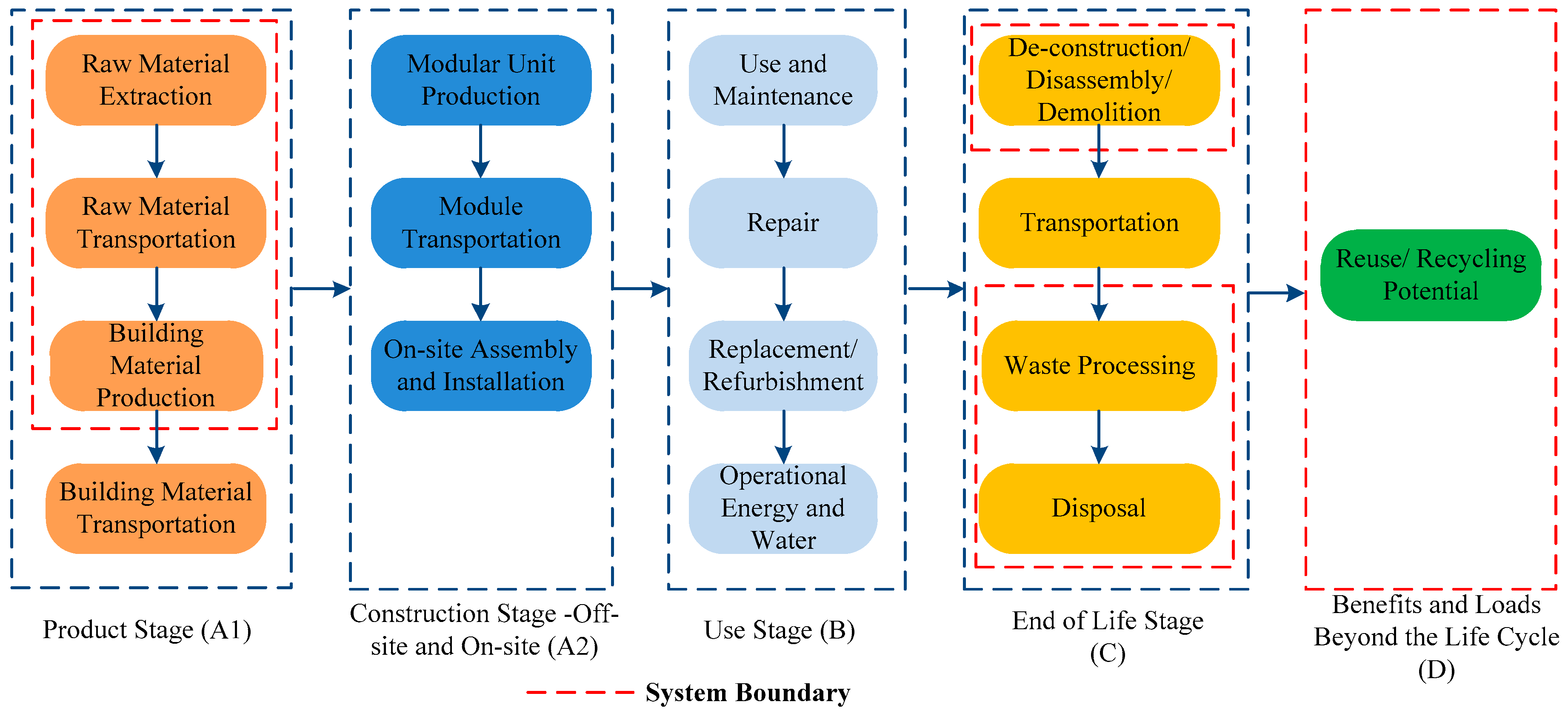


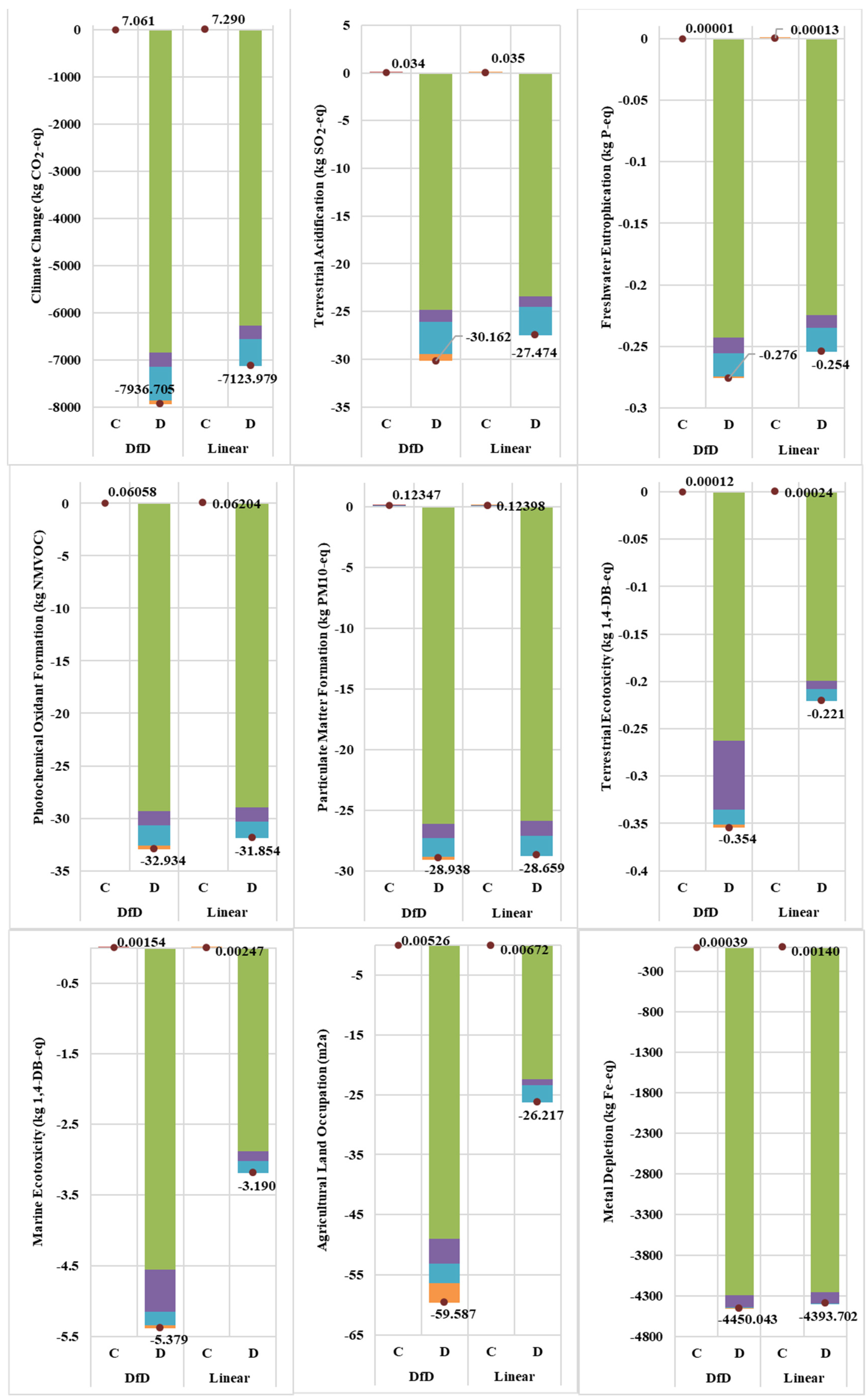
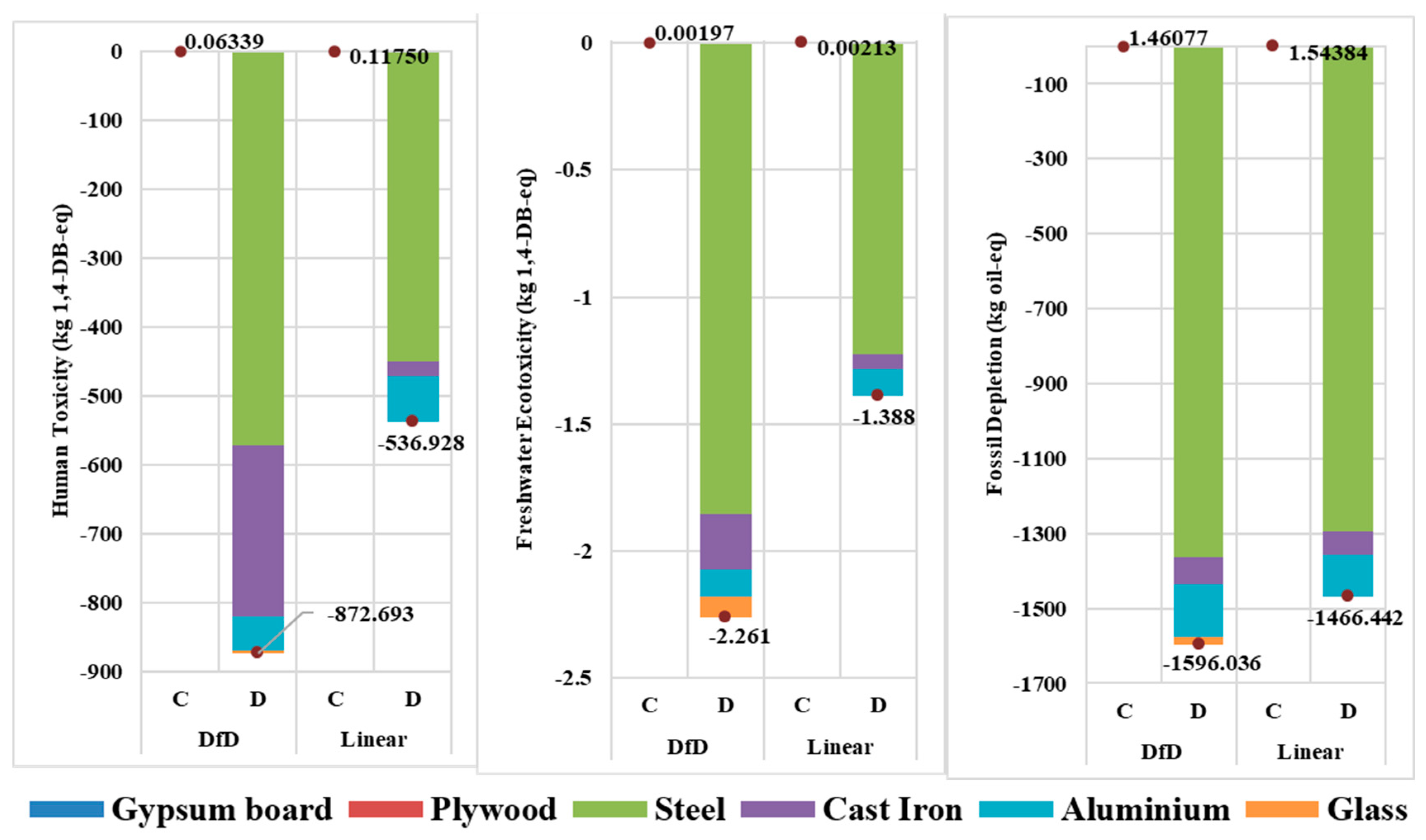
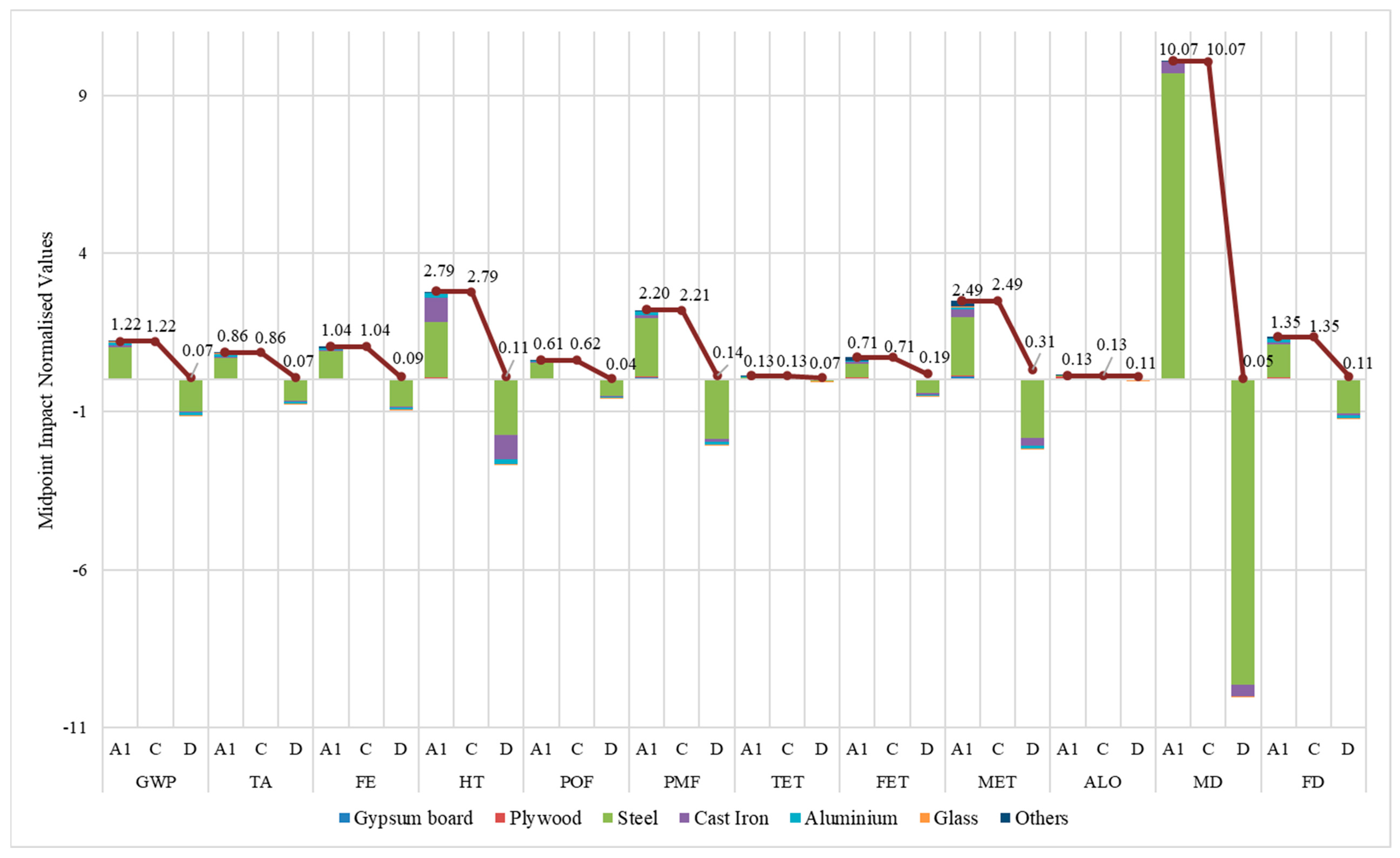

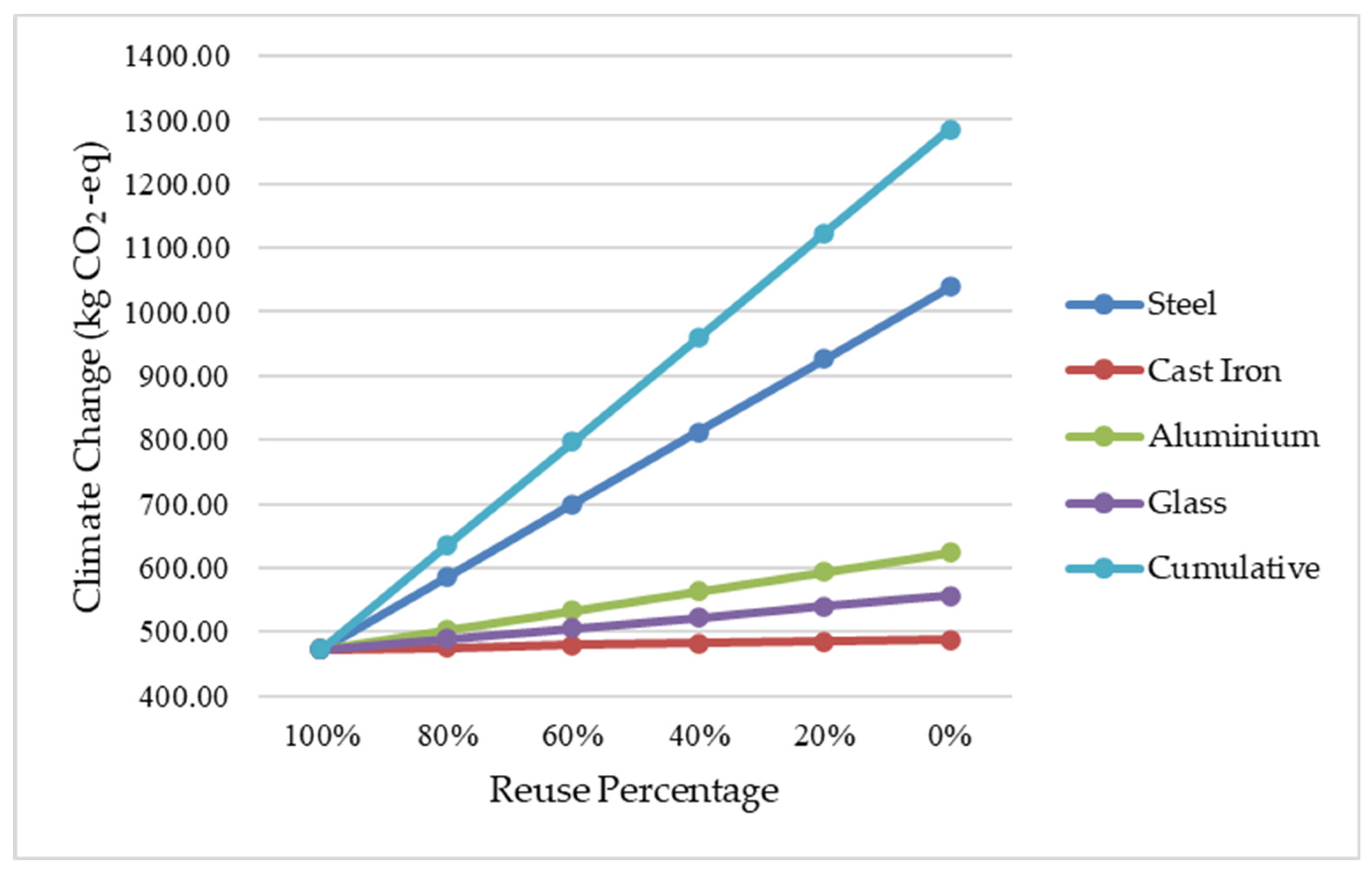
| Study | Research Design * | Study Purpose | Key Research Highlights | |||||
|---|---|---|---|---|---|---|---|---|
| SLS | QA | SBR | LCA | ES | CS | |||
| [26] | ✓ | ✓ | A conceptual framework is developed to identify barriers and propose strategies to adopt CE in modular construction | Modular buildings are key to material savings, waste reduction, and reuse of components | ||||
| [35] | ✓ | ✓ | Analysed the contemporary challenges and barriers to adopting CE in MC and proposed a strategy roadmap | 15 guidelines are proposed to overcome the obstacles to CE adoption in MC | ||||
| [9] | ✓ | ✓ | ✓ | Comparative environmental assessment of a DfD modular building and conventional construction approach | Compared to recycling, DfD offsets greenhouse gas emissions by 88% and also benefits other tested environmental impacts | |||
| [36] | ✓ | ✓ | ✓ | Compare the environmental impacts of four designs of a transportable, modular housing unit | Shows that the potential reuse of the building structure provides significant environmental benefits | |||
| [24] | ✓ | Novel virtual reality (VR)-based approach to advanced learnings and experiences of the CE in the modular construction | Provides a visual link between the building information modelling, bill of quantities and resiliency of the selected materials | |||||
| [37] | ✓ | ✓ | Investigates the critical success factors for implementing circular MC projects in Hong Kong | Revealed the vitality of the planning and design stages for achieving circularity in MC projects | ||||
| [25] | ✓ | ✓ | Investigates the integration of CE principles in MC to enhance the sustainability | 30 strategies are proposed to mitigate obstacles in adopting CE principles to solve the sustainability issues in MC | ||||
| Building Element | Description |
|---|---|
| Framing | Mild steel C sections; box bars as intermediate beams to support window and door framing; 100 mm × 100 mm webs for joining; cast iron corner posts |
| External walls | Galvanized mild steel plates |
| Internal walls and ceiling | Gypsum boards |
| Floor | Plywood boards |
| Roof | Galvanized mild steel plates |
| Insulation | Mineral wool |
| Doors and windows | Mild steel framing; one sliding double door (2100 × 1800 mm) with aluminium profile and glass; 4 single doors (2100 × 900 mm) with aluminium profile and glass; 2 windows (1500 × 2100) with aluminium profile, louvre, and glass; 2 windows (900 × 600) with aluminium profile, louvre, and glass |
| Painting and finishing | External walls with one coat of cataloy, one coat of primer, and two coats of enamel paint |
| Material/Component | Description | Unit | Quantity |
|---|---|---|---|
| Mild steel | Main structure framing, doors and windows framing, external walls, roof | kg | 3865 |
| Cast iron | Corner posts | kg | 180 |
| Gypsum boards | Internal walls and ceiling | kg | 1327 |
| Plywood boards | Floor | m3 | 0.104 |
| Glass | Doors and windows | m2 | 13.98 |
| Aluminium | Door and window profiles, window louvres | m2 | 8.58 |
| Paint, primer, thinner | Painting and finishing | kg | 30 |
| Impact Category | Unit | Steel | Gypsum Board | Cast Iron | Plywood | Aluminum | Glass | Coatings * | Total |
|---|---|---|---|---|---|---|---|---|---|
| Global warming potential | kg CO2 eq | 6848.58 | 232.46 | 307.61 | 45.40 | 729.54 | 83.26 | 162.23 | 8409.07 |
| Terrestrial acidification | kg SO2 eq | 24.86 | 1.31 | 1.26 | 0.30 | 3.48 | 0.71 | 0.81 | 32.74 |
| Freshwater eutrophication | kg P eq | 0.24 | 0.01 | 0.01 | 0.00 | 0.02 | 0.00 | 0.01 | 0.30 |
| Human toxicity | kg 1,4-DB eq | 572.30 | 16.43 | 247.39 | 5.59 | 52.00 | 2.70 | 11.11 | 907.54 |
| Photochemical oxidant formation | kg NMVOC | 29.35 | 0.86 | 1.32 | 0.32 | 2.01 | 0.40 | 0.68 | 34.94 |
| Particulate matter formation | kg PM10 eq | 26.13 | 1.16 | 1.21 | 0.22 | 1.57 | 0.23 | 0.39 | 30.91 |
| Terrestrial ecotoxicity | kg 1,4-DB eq | 0.26 | 0.15 | 0.07 | 0.01 | 0.02 | 0.00 | 0.23 | 0.75 |
| Freshwater ecotoxicity | kg 1,4-DB eq | 1.86 | 0.24 | 0.22 | 0.06 | 0.12 | 0.08 | 0.49 | 3.07 |
| Marine ecotoxicity | kg 1,4-DB eq | 4.56 | 0.25 | 0.60 | 0.06 | 0.20 | 0.04 | 0.44 | 6.14 |
| Agricultural land occupation | m2a | 49.03 | 155.38 | 4.09 | 447.40 | 3.81 | 3.19 | 20.55 | 683.44 |
| Metal depletion | kg Fe eq | 4293.20 | 17.21 | 154.80 | 0.34 | 4.01 | 1.50 | 2.89 | 4473.95 |
| Fossil depletion | kg oil eq | 1363.40 | 67.03 | 71.83 | 15.46 | 147.06 | 21.30 | 54.29 | 1740.37 |
| Impact Category | Unit | A1 | C | D | Total | ||||
|---|---|---|---|---|---|---|---|---|---|
| Gypsum Board | Plywood | Steel | Cast Iron | Aluminum | Glass | ||||
| Global warming potential | kg CO2 eq | 8409.07 | 4.10 | 2.96 | −6843.26 | −307.61 | −709.64 | −83.26 | 472.36 |
| Terrestrial acidification | kg SO2 eq | 32.74 | 0.03 | 0.00 | −24.84 | −1.26 | −3.39 | −0.71 | 2.58 |
| Freshwater eutrophication | kg P eq | 0.30 | 0.00 | 0.00 | −0.24 | −0.01 | −0.02 | 0.00 | 0.03 |
| Human toxicity | kg 1,4-DB eq | 907.54 | 0.04 | 0.02 | −571.86 | −247.39 | −50.81 | −2.70 | 34.84 |
| Photochemical oxidant formation | kg NMVOC | 34.94 | 0.06 | 0.00 | −29.33 | −1.32 | −1.95 | −0.40 | 2.00 |
| Particulate matter formation | kg PM10 eq | 30.91 | 0.12 | 0.00 | −26.11 | −1.21 | −1.51 | −0.23 | 1.97 |
| Terrestrial ecotoxicity | kg 1,4-DB eq | 0.75 | 0.00 | 0.00 | −0.26 | −0.07 | −0.02 | 0.00 | 0.40 |
| Freshwater ecotoxicity | kg 1,4-DB eq | 3.07 | 0.00 | 0.00 | −1.86 | −0.22 | −0.11 | −0.08 | 0.81 |
| Marine ecotoxicity | kg 1,4-DB eq | 6.14 | 0.00 | 0.00 | −4.55 | −0.60 | −0.19 | −0.04 | 0.76 |
| Agricultural land occupation | m2a | 683.44 | 0.00 | 0.00 | −48.99 | −4.09 | −3.33 | −3.19 | 623.85 |
| Metal depletion | kg Fe eq | 4473.95 | 0.00 | 0.00 | −4289.87 | −154.80 | −3.88 | −1.50 | 23.91 |
| Fossil depletion | kg oil eq | 1740.37 | 1.46 | 0.00 | −1362.34 | −71.83 | −142.02 | −21.30 | 144.33 |
| Impact Category | Unit | A1 | C | D | Total | ||||
|---|---|---|---|---|---|---|---|---|---|
| Gypsum Board | Glass | Plywood | Steel | Cast Iron | Aluminum | ||||
| Global warming potential | kg CO2 eq | 8409.07 | 4.10 | 0.23 | 2.96 | −6276.47 | −291.93 | −562.87 | 1285.09 |
| Terrestrial acidification | kg SO2 eq | 32.74 | 0.03 | 0.00 | 0.00 | −23.43 | −1.09 | −2.9936 | 5.27 |
| Freshwater eutrophication | kg P eq | 0.30 | 0.00 | 0.00 | 0.00 | −0.22 | −0.01 | −0.02 | 0.05 |
| Human toxicity | kg 1,4-DB eq | 907.54 | 0.04 | 0.05 | 0.02 | −450.43 | −20.95 | −65.67 | 370.61 |
| Photochemical oxidant formation | kg NMVOC | 34.94 | 0.06 | 0.00 | 0.00 | −28.97 | −1.35 | −1.60 | 3.08 |
| Particulate matter formation | kg PM10 eq | 30.91 | 0.12 | 0.00 | 0.00 | −25.88 | −1.20 | −1.70 | 2.25 |
| Terrestrial ecotoxicity | kg 1,4-DB eq | 0.75 | 0.00 | 0.00 | 0.00 | −0.20 | −0.01 | −0.01 | 0.53 |
| Freshwater ecotoxicity | kg 1,4-DB eq | 3.07 | 0.00 | 0.00 | 0.00 | −1.23 | −0.06 | −0.11 | 1.68 |
| Marine ecotoxicity | kg 1,4-DB eq | 6.14 | 0.00 | 0.00 | 0.00 | −2.89 | −0.13 | −0.17 | 2.95 |
| Agricultural land occupation | m2a | 683.44 | 0.00 | 0.00 | 0.00 | −22.35 | −1.04 | −2.83 | 657.22 |
| Metal depletion | kg Fe eq | 4473.95 | 0.00 | 0.00 | 0.00 | −4254.64 | −135.23 | −3.82 | 80.25 |
| Fossil depletion | kg oil eq | 1740.37 | 1.46 | 0.08 | 0.00 | −1295.49 | −60.26 | −112.25 | 273.93 |
| Impact Category | % Reuse | Human Toxicity (kg 1,4-DB eq) | Terrestrial Ecotoxicity (kg 1,4-DB eq) | Freshwater Toxicity (kg 1,4-DB eq) | Marine Toxicity (kg 1,4-DB eq) | Agricultural Land Occupation (m2a) |
|---|---|---|---|---|---|---|
| Steel | 100% | 34.843 | 0.398 | 0.808 | 0.757 | 623.850 |
| 80% | 59.130 | 0.411 | 0.934 | 1.090 | 629.177 | |
| 60% | 83.417 | 0.424 | 1.060 | 1.424 | 634.505 | |
| 40% | 107.703 | 0.436 | 1.186 | 1.757 | 639.832 | |
| 20% | 131.990 | 0.449 | 1.312 | 2.091 | 645.160 | |
| 0% | 156.277 | 0.462 | 1.438 | 2.424 | 650.487 | |
| Cast iron | 100% | 34.843 | 0.398 | 0.808 | 0.757 | 623.850 |
| 80% | 80.130 | 0.411 | 0.840 | 0.850 | 624.459 | |
| 60% | 125.418 | 0.423 | 0.871 | 0.943 | 625.069 | |
| 40% | 170.705 | 0.436 | 0.903 | 1.036 | 625.678 | |
| 20% | 215.992 | 0.449 | 0.935 | 1.129 | 626.288 | |
| 0% | 261.279 | 0.461 | 0.967 | 1.222 | 626.897 | |
| Aluminium | 100% | 34.843 | 0.398 | 0.808 | 0.757 | 623.850 |
| 80% | 37.816 | 0.399 | 0.808 | 0.760 | 623.948 | |
| 60% | 40.788 | 0.399 | 0.808 | 0.763 | 624.046 | |
| 40% | 43.760 | 0.400 | 0.808 | 0.765 | 624.144 | |
| 20% | 46.732 | 0.401 | 0.808 | 0.768 | 624.243 | |
| 0% | 49.704 | 0.401 | 0.808 | 0.771 | 624.341 | |
| Glass | 100% | 34.843 | 0.398 | 0.808 | 0.757 | 623.850 |
| 80% | 35.395 | 0.399 | 0.825 | 0.765 | 624.489 | |
| 60% | 35.946 | 0.399 | 0.842 | 0.773 | 625.128 | |
| 40% | 36.497 | 0.400 | 0.858 | 0.782 | 625.767 | |
| 20% | 37.049 | 0.401 | 0.875 | 0.790 | 626.406 | |
| 0% | 37.600 | 0.401 | 0.892 | 0.798 | 627.044 | |
| Cumulative | 100% | 34.843 | 0.398 | 0.808 | 0.757 | 623.850 |
| 80% | 107.941 | 0.425 | 0.982 | 1.194 | 630.524 | |
| 60% | 181.038 | 0.452 | 1.157 | 1.632 | 637.198 | |
| 40% | 254.135 | 0.478 | 1.332 | 2.070 | 643.872 | |
| 20% | 327.232 | 0.505 | 1.506 | 2.508 | 650.546 | |
| 0% | 400.329 | 0.532 | 1.681 | 2.946 | 657.220 |
| Strategy Cluster | No | Strategies |
|---|---|---|
| Design | S1 | Promote and advance design for disassembly (DfD) design approach |
| S2 | Standardise modular-based DfD designs | |
| S3 | Choice of dry technological systems instead of wet ones to elevate the disassembly potential | |
| S4 | Present multiple design options to attract more clients by demonstrating architectural freedom and creativity | |
| S5 | Design for incorporating alternative sustainable building materials/elements (i.e., local, low-cost, recycled) | |
| S6 | Incorporate the maintainability and durability criteria of the overall modules when developing sustainable alternative designs | |
| Stakeholder collaboration and communication | S7 | Close and early stakeholder engagement to understand the importance of CE integration and to formulate corresponding goals and objectives |
| S8 | Implement digital systems to communicate and collaborate considering the whole project life cycle | |
| Advanced technology integration | S9 | Integrating digital information platforms such as BIM |
| S10 | Integrating with smart technologies such as the internet of things (IoT) | |
| S11 | Employ advanced production technologies such as additive manufacturing and automation | |
| Materials | S12 | Timber-based technologies for structural framing, such as CLT and Glulam |
| S13 | Employ green building material alternatives such as building panels with recycled content | |
| Research and development approaches | S14 | Develop mechanisms to incorporate processed construction and demolition waste from conventional construction projects |
| S15 | Sustainability assessments to evaluate sustainability performance and to identify process and material hotspots | |
| S16 | Comprehensive methodologies to quantify the recovery potentials and reusability indexes at the EoL stage | |
| S17 | Comprehensive assessment methods to quantify regional-base sustainability impacts from EoL deconstruction, transportation, sorting and reprocessing activities | |
| S18 | Build effective and sustainable material passport tools to store and share information in the whole life cycle to benefit EoL and the next product system stages | |
| Whole project life cycle planning | S19 | Formulate a disassembly and selective demolition plan to realise the reuse and recycling of building materials and elements at EoL stage |
| S20 | Comprehensive strategies to support reverse logistics of disassembled or demolished materials to the following processing or product stage | |
| Policy, regulations, codes, and financial support | S21 | Government policies and regulations to mandate the use of modular construction and CE approaches |
| S22 | Develop comprehensive design codes, standards, and technical guidance for synergising MC, DfD and CE methods | |
| S23 | Financial support and investments from government and non-government financial organisations to aid CE diffusion | |
| S24 | Financial incentives from the government to encourage and enable small-scale and local manufacturers to adopt CE-driven MC practices | |
| Improve technical knowledge and general awareness | S25 | Industry-level workshops, training, and seminars to enhance the technical skills and knowledge of project teams, labourers and other practitioners |
| S26 | Awareness programmes on the benefits of CE thinking in MC to key project stakeholders such as manufacturers, builders, and other practitioners | |
| S27 | Promotional and informative programmes (workshops, exhibitions, and online events) to clients and the general public to promote and raise awareness on concepts of MC and CE |
Disclaimer/Publisher’s Note: The statements, opinions and data contained in all publications are solely those of the individual author(s) and contributor(s) and not of MDPI and/or the editor(s). MDPI and/or the editor(s) disclaim responsibility for any injury to people or property resulting from any ideas, methods, instructions or products referred to in the content. |
© 2023 by the authors. Licensee MDPI, Basel, Switzerland. This article is an open access article distributed under the terms and conditions of the Creative Commons Attribution (CC BY) license (https://creativecommons.org/licenses/by/4.0/).
Share and Cite
Jayawardana, J.; Sandanayake, M.; Kulatunga, A.K.; Jayasinghe, J.A.S.C.; Zhang, G.; Osadith, S.A.U. Evaluating the Circular Economy Potential of Modular Construction in Developing Economies—A Life Cycle Assessment. Sustainability 2023, 15, 16336. https://doi.org/10.3390/su152316336
Jayawardana J, Sandanayake M, Kulatunga AK, Jayasinghe JASC, Zhang G, Osadith SAU. Evaluating the Circular Economy Potential of Modular Construction in Developing Economies—A Life Cycle Assessment. Sustainability. 2023; 15(23):16336. https://doi.org/10.3390/su152316336
Chicago/Turabian StyleJayawardana, Janappriya, Malindu Sandanayake, Asela K. Kulatunga, J. A. S. C. Jayasinghe, Guomin Zhang, and S. A. Udara Osadith. 2023. "Evaluating the Circular Economy Potential of Modular Construction in Developing Economies—A Life Cycle Assessment" Sustainability 15, no. 23: 16336. https://doi.org/10.3390/su152316336
APA StyleJayawardana, J., Sandanayake, M., Kulatunga, A. K., Jayasinghe, J. A. S. C., Zhang, G., & Osadith, S. A. U. (2023). Evaluating the Circular Economy Potential of Modular Construction in Developing Economies—A Life Cycle Assessment. Sustainability, 15(23), 16336. https://doi.org/10.3390/su152316336







_Zhang.png)

